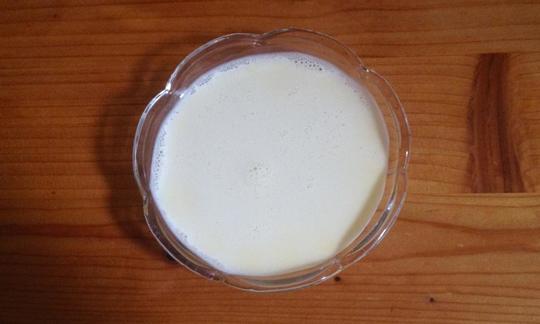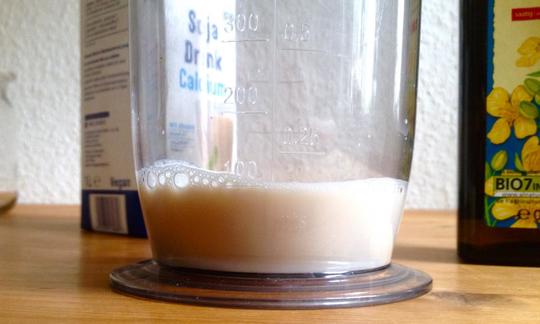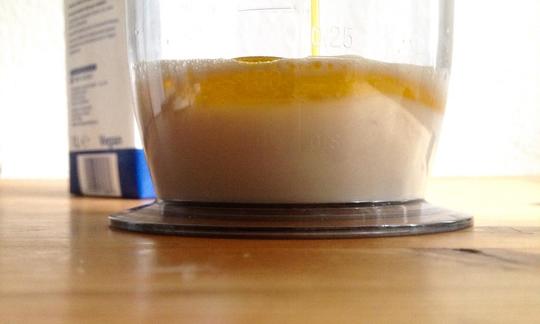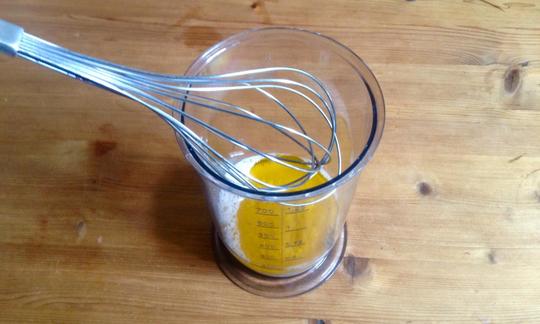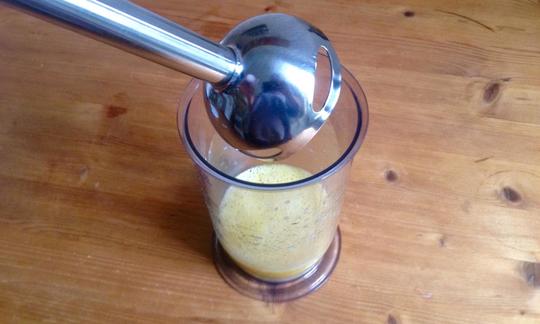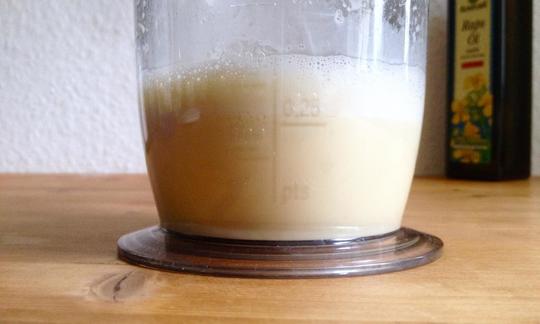soy cream with rapeseed oil instead of olive oil
vegan
Ingredients (for serving, )
| 100 ml | Soy milk with vanilla, (organic?, raw?) (3.6 oz) |
| 50 ml | Rapeseed oil (canola, HOLL oil, kernel oil), cold pressed?, organic? (1.6 oz) |
Equipment
- hand-held blender / immersion blender or blender
- whisk
Type of preparation
- food preparation without heating
- beat
Preparation
Measure out the soy milk and rapeseed oil and combine them in either a bowl or a tall blender.
If you are mixing with a whisk, it is better to use a bowl. However, it is advisable to make the cream with an electric mixer (with whisk attachments) or with a hand blender. If you are using your hand, you will need to beat very quickly and for a long time to achieve the desired consistency. If you are mixing with a hand blender, it is a good idea to pour the liquids into a tall mixing bowl.
Then mix the components until you reach a creamy, homogenous consistency. Now you can either use the soy cream straight away or keep it cool. Mixing soy milk or soy cream with rapeseed oil instead of olive oil has health benefits.
|
Nutritional Information per person
Convert per 100g
|
2000 kcal | |
|---|---|---|
| Energy | 463 kcal | 23.2% |
| Fat/Lipids | 48 g | 68.4% |
| Saturated Fats | 3.6 g | 18.0% |
| Carbohydrates (inc.dietary fiber) | 6.5 g | 2.4% |
| Sugars | 4.1 g | 4.6% |
| Fiber | 0.62 g | 2.5% |
| Protein/Albumin | 3.4 g | 6.8% |
| Cooking Salt (Na:52.8 mg) | 134 mg | 5.6% |
| Essential micronutrients with the highest proportions | per person | 2000 kcal | |
|---|---|---|---|
| Fat | Alpha-Linolenic acid; ALA; 18:3 omega-3 | 4.3 g | 215.0% |
| Fat | Linoleic acid; LA; 18:2 omega-6 | 9.2 g | 92.0% |
| Vit | Vitamin E, as a-TEs | 8.2 mg | 68.0% |
| Vit | Vitamin K | 36 µg | 48.0% |
| Vit | Vitamin A, as RAE | 277 µg | 35.0% |
| Prot | Tryptophan (Trp, W) | 0.04 g | 16.0% |
| Min | Copper, Cu | 0.13 mg | 13.0% |
| Min | Manganese, Mn | 0.23 mg | 12.0% |
| Prot | Threonine (Thr, T, irreversibly transaminated) | 0.11 g | 12.0% |
| Prot | Isoleucine (Ile, I) | 0.12 g | 10.0% |
Detailed Nutritional Information per Person for this Recipe
The majority of the nutritional information comes from the USDA (US Department of Agriculture). This means that the information for natural products is often incomplete or only given within broader categories, whereas in most cases products made from these have more complete information displayed.
If we take flaxseed, for example, the important essential amino acid ALA (omega-3) is only included in an overarching category whereas for flaxseed oil ALA is listed specifically. In time, we will be able to change this, but it will require a lot of work. An “i” appears behind ingredients that have been adjusted and an explanation appears when you hover over this symbol.
For Erb Muesli, the original calculations resulted in 48 % of the daily requirement of ALA — but with the correction, we see that the muesli actually covers >100 % of the necessary recommendation for the omega-3 fatty acid ALA. Our goal is to eventually be able to compare the nutritional value of our recipes with those that are used in conventional western lifestyles.
| Essential fatty acids | per person | 2000 kcal |
|---|---|---|
| Alpha-Linolenic acid; ALA; 18:3 omega-3 | 4.3 g | 215.0% |
| Linoleic acid; LA; 18:2 omega-6 | 9.2 g | 92.0% |
| Essential amino acids | per person | 2000 kcal |
|---|---|---|
| Tryptophan (Trp, W) | 0.04 g | 16.0% |
| Threonine (Thr, T, irreversibly transaminated) | 0.11 g | 12.0% |
| Isoleucine (Ile, I) | 0.12 g | 10.0% |
| Leucine (Leu, L) | 0.19 g | 8.0% |
| Phenylalanine (Phe, F) | 0.12 g | 8.0% |
| Valin (Val, V) | 0.12 g | 8.0% |
| Lysine (Lys, K, irreversibly transaminated) | 0.14 g | 7.0% |
| Methionine (Met, M) | 0.03 g | 3.0% |
| Vitamins | per person | 2000 kcal |
|---|---|---|
| Vitamin E, as a-TEs | 8.2 mg | 68.0% |
| Vitamin K | 36 µg | 48.0% |
| Vitamin A, as RAE | 277 µg | 35.0% |
| Vitamin B9, B11 (Folate, as the active form of folic acid) | 19 µg | 9.0% |
| Vitamin B1 (Thiamine) | 0.06 mg | 6.0% |
| Vitamin B5 (Pantothenic acid) | 0.39 mg | 6.0% |
| Vitamin B6 (pyridoxine) | 0.08 mg | 6.0% |
| Vitamin B2 (Riboflavin) | 0.07 mg | 5.0% |
| Vitamin B3 (Niacin) | 0.53 mg | 3.0% |
| Essential macroelements (macronutrients) | per person | 2000 kcal |
|---|---|---|
| Phosphorus, P | 54 mg | 8.0% |
| Magnesium, Mg | 26 mg | 7.0% |
| Sodium, Na | 53 mg | 7.0% |
| Potassium, K | 122 mg | 6.0% |
| Calcium, Ca | 26 mg | 3.0% |
| Essential trace elements (micronutrients) | per person | 2000 kcal |
|---|---|---|
| Copper, Cu | 0.13 mg | 13.0% |
| Manganese, Mn | 0.23 mg | 12.0% |
| Selenium, Se | 5.0 µg | 9.0% |
| Iron, Fe | 0.66 mg | 5.0% |
| Zinc, Zn | 0.12 mg | 1.0% |
Soy cream with rapeseed oil instead of olive oil offers an alternative to conventional cream for those who avoid animal products.
Soy cream: Although soy cream has now found its way onto almost every supermarket shelf due to its increasing popularity as a substitute for vegans or lactose intolerant people, making your own only takes a few minutes and tastes just as good. In addition to the fact that soy cream does not contain lactose, it has a wider range of nutrients due to the plant-based origin of soy milk.
Oil as raw food: If you want to use rapeseed oil or other vegetable oils as raw food, you should pay close attention to the product information when purchasing. The term "organic", which is protected in the EU, indicates ecologically controlled cultivation, but does not necessarily indicate processing. A frequently used process in vegetable oil processing, known as deodorization, is a technical process in which steam distillation is used (according to Wikipedia, the oil reaches temperatures of over 200 °C for more than 20 minutes) to specifically remove certain odorous substances.
Making soy whipped cream: You can use the recipe presented here to make rapeseed oil-based soy whipped cream from the soy cream obtained here. However, if you do not have the ingredient agar-agar, you will have to resort to special "whipping creams". This is necessary because ordinary soy cream without additives cannot normally be whipped. The so-called "whipped creams" made from plant-based cream are a vegan alternative to milk-based cream. As the name suggests, they are suitable for whipping.
Alternative oil: Depending on your preference, you can use a different oil instead of the one proposed here rapeseed oil. This will give the cream a different flavour. However, it should be noted that certain oils, such as olive oil, have a lower percentage of essential fatty acids than the rapeseed oil we recommend.
Spices and consistency: If you want to add additional flavor components to the soy cream,vanilla or cinnamon are suitable. If you also want to change the consistency of the cream, coconut oil is a good choice. the necessary prerequisites.

